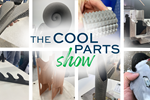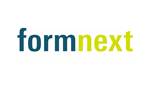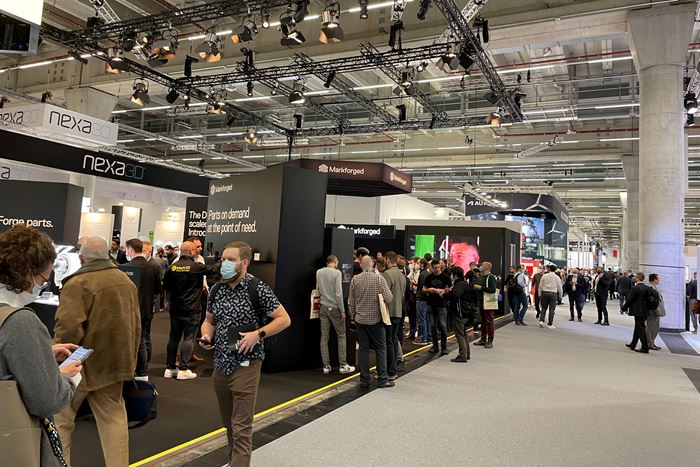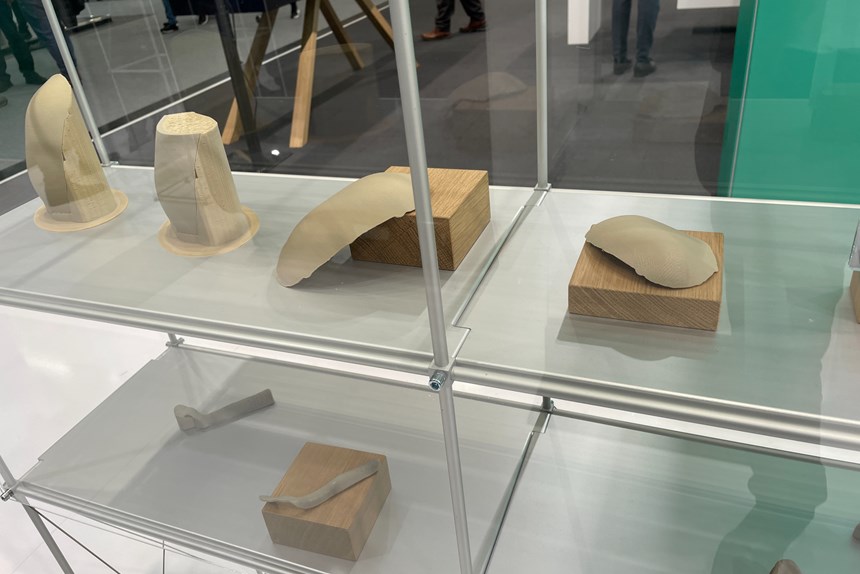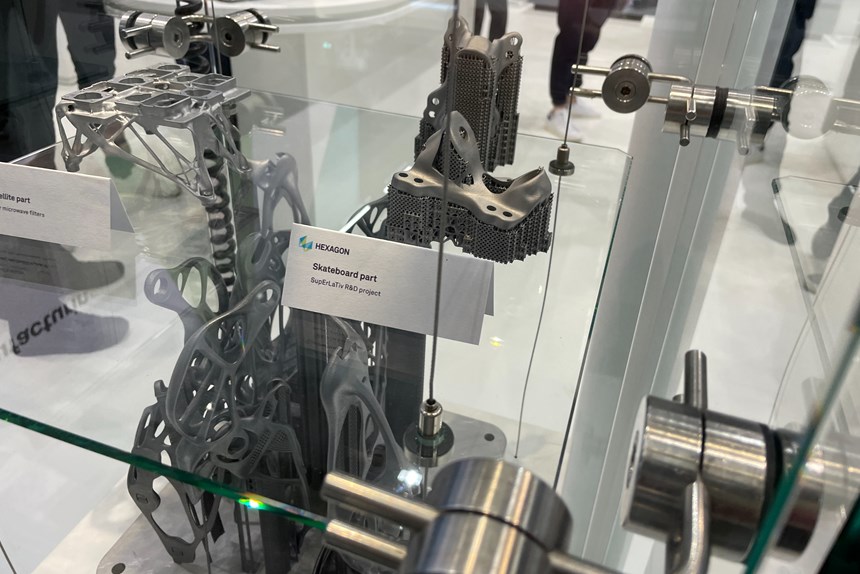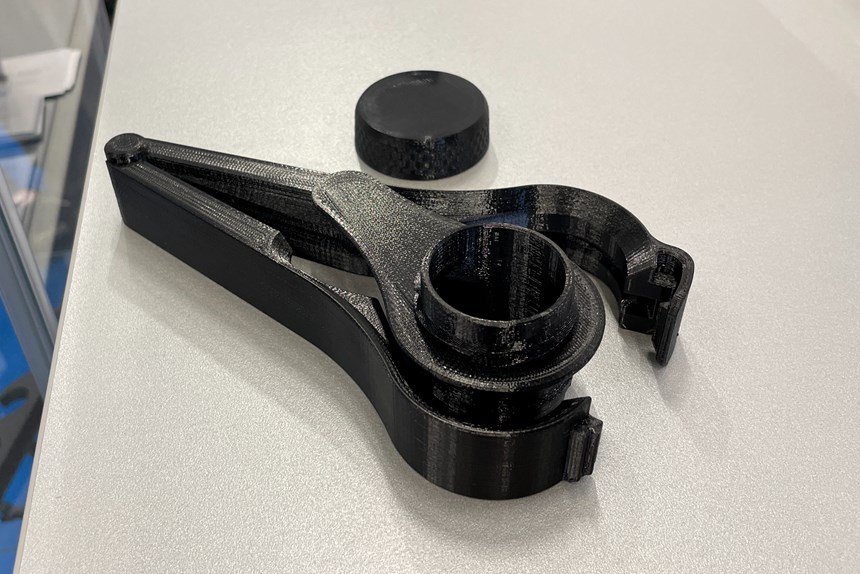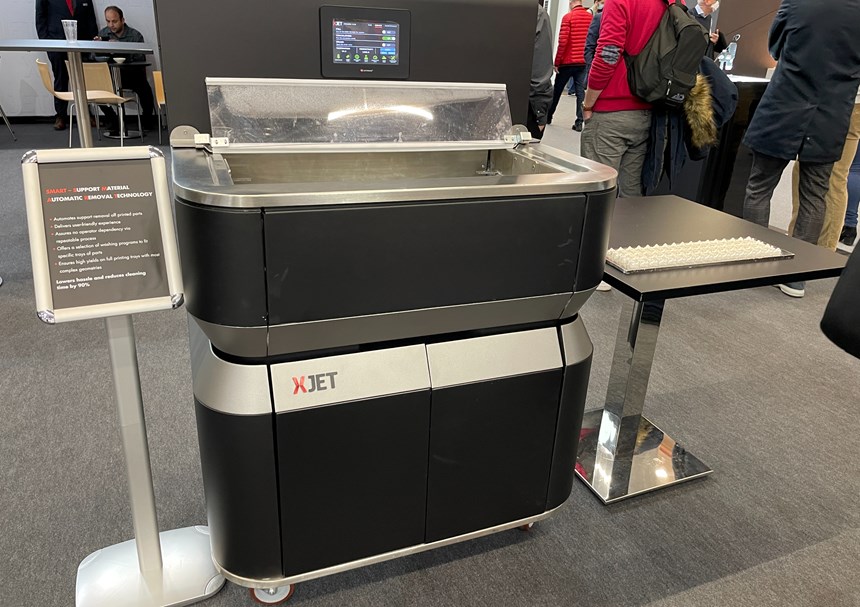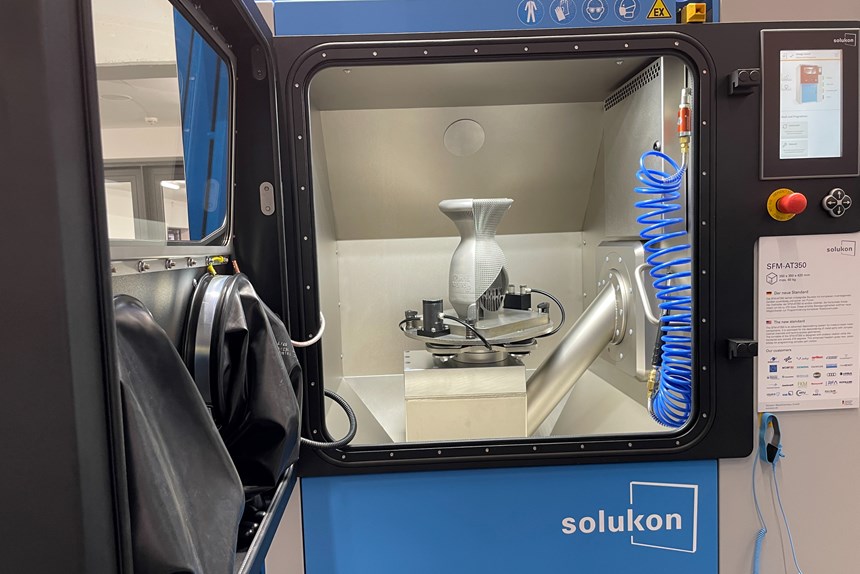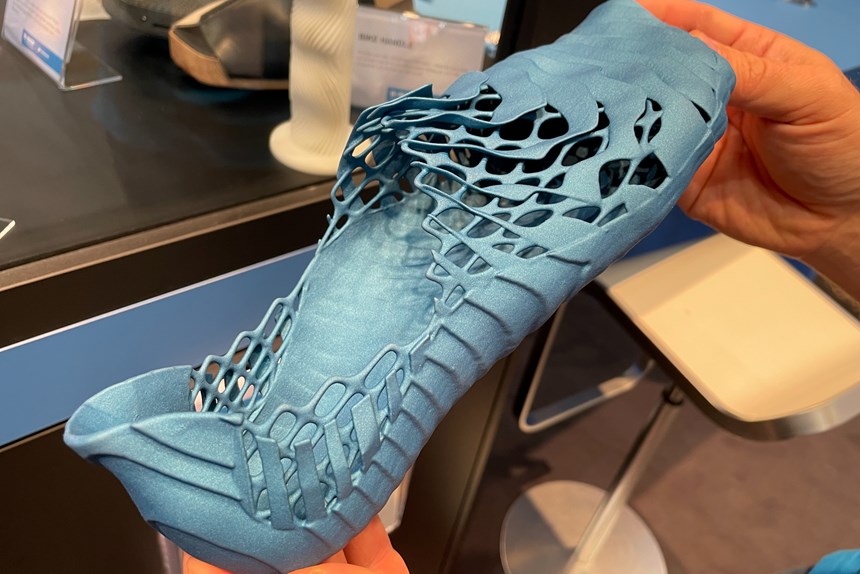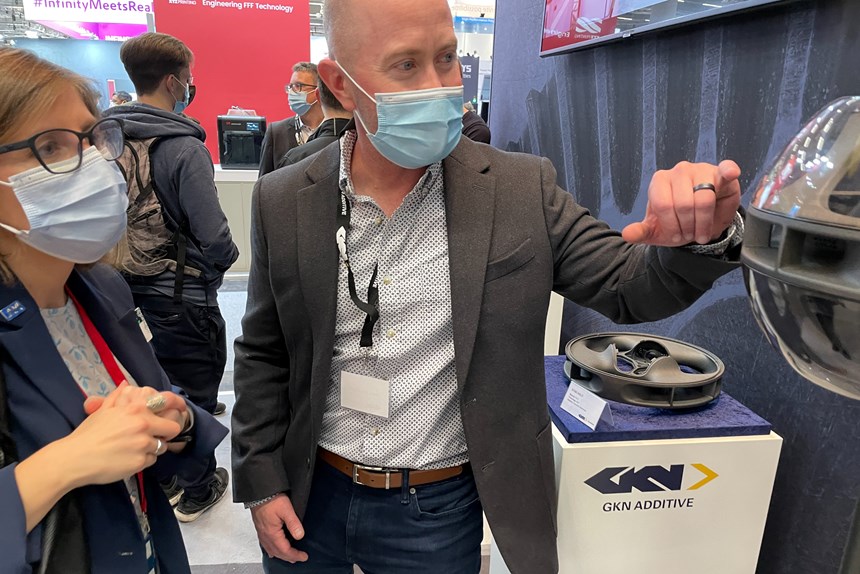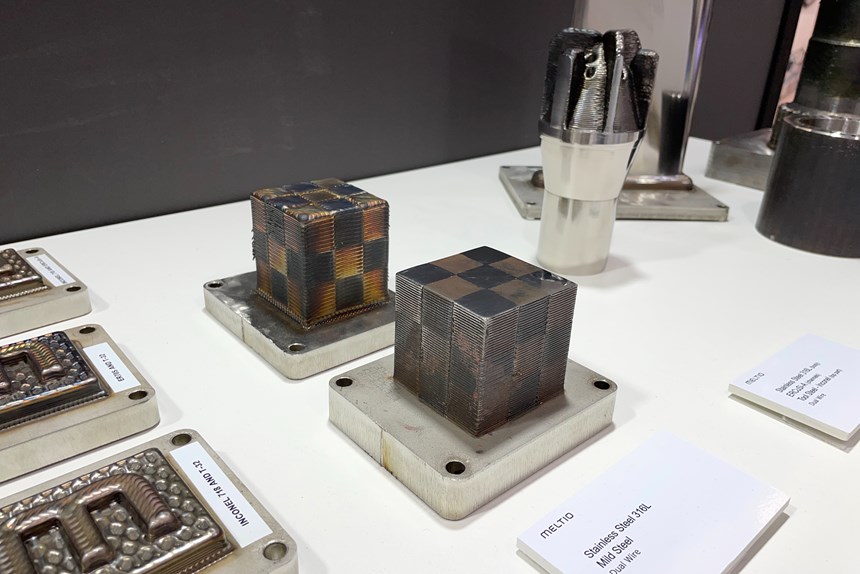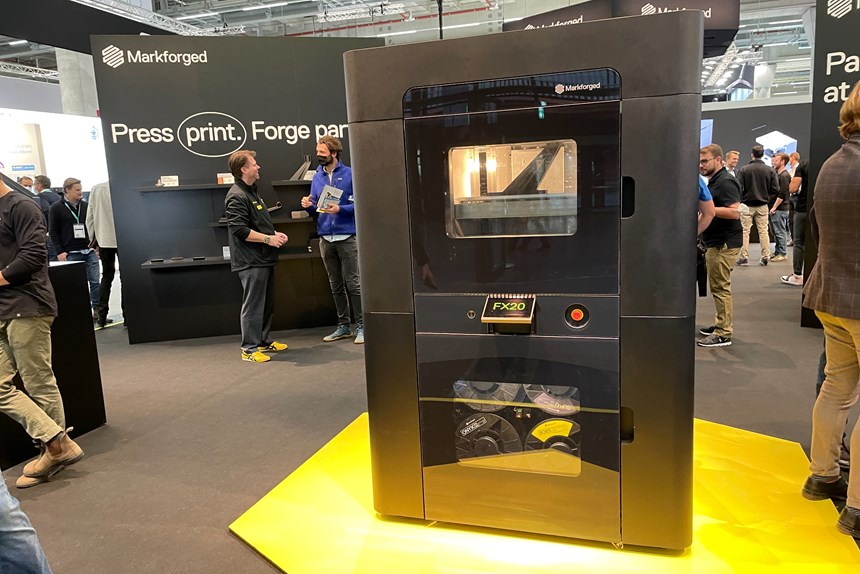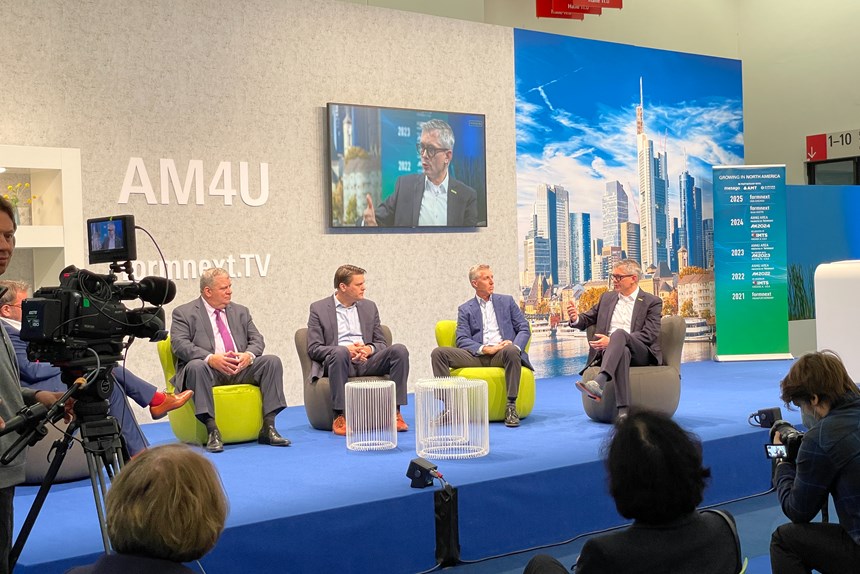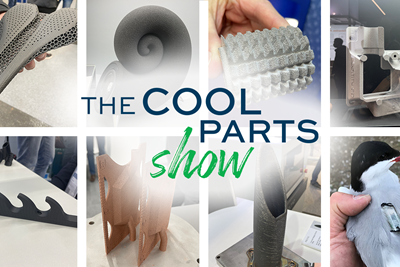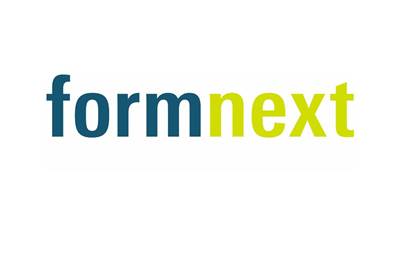After a virtual-only event for 2020, Formnext returned to the halls of Messe Frankfurt in Germany with a physical trade show for 2021. Held November 16-19, the event was only somewhat diminished in footprint from its 2019 incarnation; exhibits covered three floors within two halls of the venue (versus four floors previously) and more than 600 exhibitors from 36 countries were represented. According to Mesago Messe Frankfurt GmbH, organizer of the show, attendance reached 17,859 with visitors traveling from 76 nations.
Its size aside, perhaps the most striking thing about this year’s Formnext was the variety of equipment, ideas and trends that were represented. Additive manufacturing (AM) extends well beyond the 3D printer, and that expanse was evident in the diversity of exhibitors which included software developers, materials suppliers and postprocessing equipment in addition to printer manufacturers. The applications on display also spoke to the continued spread of AM across industries; 3D printing now touches everything from footwear to realistic dental implants to more powerful rocket engines, but promises to extend its reach even further.
Formnext 2021 revealed where additive is, now nearly two years into a globally disruptive time period, but also offered hints about where it is going. Read on for 10 trends in evidence at the show and flip through the slideshow below for a sampling of what was on display.
Sights from Formnext 2021
1. The Pandemic’s Influence: Both Hurdle and Boost
While covid-19 has presented challenges to equipment suppliers and parts producers alike, Formnext 2021 exhibitors were more likely to point to the ways it has changed or accelerated the advance of additive manufacturing. The pandemic has forced vulnerable supply chains into the spotlight and initiated new conversations about how and where production happens; for companies that have touted the advantages of distributed and on-demand manufacturing, this has been vindicating and motivating. Guayente Sanmartin, the global head and general manager of HP’s Multi Jet Fusion business, noted how emergency efforts helped OEMs realize the manufacturing possibilities with 3D printing, a realization that is now driving some to shore up their supply chains with additive. Stratasys CEO Yoav Zeif shared how the company’s relationship to its customers has also changed, saying that two years ago sales conversations were primarily with engineers; now, they are with executives and leaders who see the business case for additive first and its technical advantages second.
Recognizing the business case for additive does not necessarily lead a company to add this capacity, however. New platforms like Replique, a spinout from BASF, allow OEMs to take advantage of AM’s benefits without having to own or add equipment. The platform helps companies digitize their parts for storage in a secure digital inventory; manufacturing partners located around the world can then 3D print spare parts, accessories or whatever is needed on-demand; the solution is a way to offer replacement parts in perpetuity but also a means to test new products, offer upgrades and limit physical inventory. Replique customers Miehl and Siena Garden were both represented in the company’s booth with consumer products and parts that can now be purchased and delivered through this platform.
See one such part from Siena Garden in the video below:
There are also those companies that found internal opportunities brought about by the slow down in sales and travel opportunities. XJet chief business officer Dror Danai says 2020 forced the company “back into the lab” to work on improving its NanoParticle Jetting technology, a process that deposits ceramic or metal powders in a slurry; liquid is evaporated out of the green parts as they are printed, and then the forms are sintered to their final dimensions and properties. Coming out of this slow down, Danai cites three areas where the platform was improved: 1) a stabilized, more reliable NPJ process, 2) more materials and 3) the Support Material Automated Removal Technology (SMART) Station, an automated postprocessing system displayed at the show for cleaning printed parts of their support structures.
2. Digital Is the Hidden Half of Advancement
Arguably the most striking advance to be detected at the show this year related to an area of development that is difficult to see at trade shows. This theme is so broad it might actually be multiple themes in one, and we expect we might discover this in future years as this theme further advances and clarifies. The development is this: Additive manufacturing is increasingly coming into its own and delivering on its promise as a digital manufacturing technology. At Formnext this year, in many encounters with exhibitors, we came away with the realization that the machines on display are at best half the story, albeit a vital and important half. The other half relates to digital capabilities, and what these digital capabilities can bring to a manufacturing system when it is built on 3D printing.
Arburg exemplified this. The company’s Freeformer system uses the same pelletized stock as injection molding machines (Arburg is also a well-established injection molding machine maker) to make parts through 3D printing. And Freeformer platforms have advanced. The company showed its Freeformer 300-3X model capable of higher bed temperatures, making it effective for 3D printing in higher-temperature polymers such as PEEK. This makes the machine more attractive for medical applications, for example, where PEEK is an accepted and widely used material. However, at a PC workstation near the machine, Arburg was also able to demonstrate its ProcessLog app. Capturing and contextualizing process data throughout the build of each part gives the user of this app an accessible and comprehensive view into the behavior of the AM process and the variation, if any, between different parts. 3D printing is the one manufacturing process that creates a part literally digitally, literally voxel by voxel, and marshaling this data inherent to this is an important area of 3D printing’s promise. The ProcessLog software provides for full process traceability, so it is valid to pose the question: In terms of the promise of additive manufacturing for medical part production, which advance is more significant — printing with PEEK, or monitoring the process and parts with a system such as the traceability app?
The need for traceability is also now understood to extend beyond the printer itself and into postprocessing, which in many cases has been analog and manual. Bringing cleaning and finishing steps into the digital thread was a trend articulated by several exhibitors — more on this in a moment.
Digital capabilities at the front end of the process are advancing just as readily. Indeed, additive draws on a wealth of distinctive and special digital part design capabilities just as much as it potentially offers a wealth of digital information about the parts. One example: Carbon (displaying in the Oechsler booth at Formnext) introduced its Design Engine software — a design tool specifically for working with lattices. A significant share of the promise of additive manufacturing relates to the freedom to employ lattices as a geometric form for lightweighting, cooling and tunable spring tension to replace padding. Design Engine allows part designers to choose among different lattice types, as well as to control cell size and strut thickness of lattices, in order to achieve different stress-strain relationships within the part or within a region of the part, as seen in this example:
Another example: Hexagon. This company has something like the same challenge as Arburg. The company is associated with measurement and inspection systems for additive parts — sophisticated hardware helping to obtain that wealth of data on the back end of the process. However, the expansion of Hexagon’s offerings has made it just as much a provider of design software for additive as well. One CAM capability Hexagon highlighted was the company’s Simufact Additive software for (among other things) optimizing part orientation and support structure design in AM processes.
3. Postprocessing Goes Digital, Automated
Even as additive manufacturing becomes a more widely accepted production technology, “Nobody is buying parts straight from the printer,” notes Julien Marcilly, deputy CEO of metal 3D printer provider AddUp. That’s one reason the company recently announced a partnership with PostProcess Technologies that aims to incorporate greater automation and traceability for cleaning and finishing, the steps where today the digital thread tends to break down. Bridging this gap brings potentially huge implications for AM production. Preserving traceability through postprocessing might mean less destructive testing and other controls are needed down the line, which could simplify the qualification process for parts. It may even allow manufacturers to gather data about parts in these steps that can inform the design and development of new ones. 3D printed parts are already created with an eye toward design for additive manufacturing (DFAM) as well as their intended function, but with a digital feedback loop, postprocessing could inform their development as well.
There was also an uptick in automated systems for cleaning and postprocessing of parts. XJet’s SMART Station, described above, potentially represents hours of labor savings compared to manual cleaning and support removal — but also provides a more repeatable, reliable way to achieve final parts, a necessity for 3D printing in production. In some cases, automated postprocessing makes additive manufacturing not only more productive but safer as well. Equipment provider Solukon showcased depowdering systems for medium to large-sized powder bed fusion parts; the largest of its machines can remove powder from parts as tall as 1 meter which would be awkward, heavy and possibly dangerous to clean by hand. Additionally, the automated systems are fully enclosed, protecting personnel from exposure to potentially hazardous metal powders.
4. Changes to Consumer Choice Are Coming
What industry sector stands to be changed the most by the arrival of additive manufacturing for part production? One might point to implants or aircraft. Also, there is an excellent case to be made for the space industry. But the application successes seen around Formnext 2021 add up to the conclusion that consumer products might well be the product sector to be most transformed by 3D printing.
The evidence of this could be seen not in any major example, but in many seemingly small ones. ExOne and GKN both showed compact audio speaker systems enabled by 3D printed components. BASF showed multiple footwear projects well underway, one aimed at better resource use through a circular-economy model of production (Hilos, which we have covered) and one a project aimed at realizing the promise of footwear mass-customized for individual feet. As noted above, Carbon’s lattice design capabilities were in full use in a bike saddle realizing fine-tuning of softness and stiffness throughout the 3D printed form, and Nexa3D was back with the Arcimoto FUV (it also showed it at Rapid+TCT), which hints at how 3D printing will enable electric vehicles for narrower markets than we traditional associate with car manufacturing. (Worth noting: Nexa3D also premiered a desktop-sized resin-based 3D printer, the XiP, that is equally applicable for industrial and home users — arguably a consumer product in its own right.)
All of these products are either obscure or expensive right now — not really accessible to consumers en masse. But consider: That limitation has always been the starting point with consumer products. The items that either the wealthy or the early adopters are enjoying today become the products that mass consumers widely have access to a decade or so later. At Formnext, we have seen hints at how manufacturing enterprises will change, and just as much, we are now seeing hints at the changes to come in the range and type of products all of us will take for granted.
5. Polymer Composites Become an AM Focus
If there a particular part-making possibility that made the most decisive advance since the last in-person Formnext, it might be the opportunity presented by 3D printed polymer composites. In the past, this has been predominately something of an offshoot or an interesting possibility for polymer 3D printed machines: the chance to also print with polymer that contains reinforcement, often chopped carbon fiber reinforcement for stronger polymer parts. But notable at this year’s Formnext were machines specifically engineered for production with reinforced polymer composite. MarkForged, for example, has long been here — its original desktop machine was capable of continuous fiber reinforcement. At Formnext, the company showed an industrial-size composite machine. Its FX20 features five times the build volume of its desktop-size machines, not just for large parts but also for batches of small ones. But perhaps an even more striking example is the ProM IS 500 machine from Anisoprint, which at a glance resembles a CNC machine tool. Indeed, it essentially is this, but for a very different purpose: The 10-servo-axis machine precisely controls polymer deposition and continuous fiber placement to manufacturing lightweight polymer composite hardware to take the place of parts that might otherwise be machined from aluminum or steel:
Additive manufacturing will be such a powerful enabler to manufacturing with composites that we will come to think of this as a separate broad materials area for AM’s application — that is, a third choice in addition to polymer and metal.
6. New Options for Multimaterial 3D Printing
And yet, there may also be a fourth choice in the opportunity to combine different materials within the same print. While multimaterial 3D printing has been possible for some time, various novel and unusual techniques for accomplishing multiple material prints were represented at Formnext 2021. Meltio, a company that offers affordable directed energy deposition (DED) solutions, showcased 3D printed parts made with various types of metals. The company’s deposition head supports the use of up to four different wires in a single print, and is also compatible with powder. Various parts in the company’s booth showed off this capability such as a stainless steel drill body featuring copper veins for better temperature control and a turbine blade printed from stainless steel but augmented with Inconel at its point of wear. Multimaterial DED introduces new manufacturing possibilities as well as repair opportunities — damaged parts can be built back up rather than scrapped.
DED is perhaps the metal 3D printing method most naturally suited to multimaterial 3D printing, but the technique is now possible through laser powder bed fusion as well. Aconity3D, which provides fully customizable laser powder bed fusion 3D printers, offers a multimaterial print option that relies on precise control over recoating to make this possible. In a multimaterial configuration its 3D printers can be equipped with either two or three rollers, each of which deposits a different metal powder, in the precise pattern needed by each layer of the part, before each layer is fused together. An open machine architecture that includes flexible control of the laser power, spot size and shape during the build support this capability.
But multimaterial 3D printing need not be limited to metals or even just one material type. It is also possible to mix materials as demonstrated by Lithoz, which showed off multimaterial prints combining metals and ceramics. The company’s lithography-based process accomplishes this with two vats of filled resin; the build platform can move between both materials during the build to produce gradients or sections of the different materials. As long as the two can be sintered at a similar temperature, these different materials can be compatible in a final part.
7. Machines Answer the Demand for Size
One advance apparent at the show is as important as it is easy to describe: Machines are getting bigger. Larger build volume is likely the broadest, most consistent and most fundamental need being asked by users of additive equipment, and the makers of this equipment are responding. The large travels are important not just for larger parts, but because for certain additive processes (including powder bed in metal and digital light processing in polymer), the speed of the energy source combined with the freedom to nest parts means that build size directly translates to productivity. Big size means efficient production.
There were plenty of examples of bigger machines to be seen throughout the show, too many to list. This video cites CMS and CEAD, as well as Siemens, noting the important role of digital programming and control capabilities when it comes to making use of large travels for precise metal deposition:
A notable counter-example to this theme is Essentium. This is a company already offering a larger-travel machine, in part because efficient part production is the aim it has targeted from the beginning. At Formnext, Essentium introduced its HSE 240 HT, a smaller-travel dual-extruder machine additive manufacturers can use for part and process development. This machine recognizes how, in AM, the smaller machines play an important role in preparing for full production on the productions machines that are larger. Nexa3D introduced a similar option in its XiP 3D printer — while designed as a user-friendly desktop option for resin-based printing, the small-format machine uses the same software and a selection of the same materials developed for the company’s larger NXE and NXD printers so that production could be rapidly scaled up by moving from one to the other.
8. Higher Temperature Raises Material Options
A companion theme hidden within the other themes here is higher temperature for polymer machines. Arburg and MarkForged, mentioned elsewhere, are both examples of this. As we talked to 3D printer makers about their larger-format machines, often they were quick to describe them as being not only “bigger” but also “hotter.”
That is, machines are increasing in range not only in terms of chamber size or travels, but also in terms of the range of materials they can work with effectively. Materials such as PEEK and Ultem demand higher-temperature machines. The move to engineer higher-temperature capacity into polymer 3D printers is a move that directly correlates to greater freedom of material choice for AM users.
9. Suppliers Are Increasingly Producers
While in other manufacturing sectors, the capital equipment suppliers’ involvement might be relegated to sales and service, in additive manufacturing suppliers are increasingly parts producers in their own right. In AM, the supplier who is also actively engaged in producing via 3D printing can advance its technology further and faster by virtue of exposure to the real problems of production — a trend reflected in several manifestations at the show.
For one, many companies providing 3D printers geared toward production are now 3D printing some of the parts that go into those very systems. The H350 SAF on display in the Stratasys booth, for instance, includes 35 parts printed on the platform. Elsewhere at the show, Aconity3D featured a component of its AconityScan system made with the company’s laser powder bed fusion platform using Equispheres aluminum powder. More about the unique role of the material in this part in the video below:
But increasingly, technology suppliers are also producing parts for external customers, as is the case for AddUp. The company, which is a joint venture of Fives and Michelin, offers its own laser powder bed fusion equipment as well as directed energy deposition (DED) technology by virtue of its 2018 acquisition of BeAM. To the casual observer the company might have resembled any other equipment seller at the show, but deputy CEO Julien Marcilly made it clear that AddUp is just as interested in selling parts as it is machines. Its North American headquarters in Cincinnati, for instance, will have 18 production-ready machines next year for the purpose of manufacturing parts for customers not yet ready to purchase their own equipment, or for whom the need is not yet large enough to justify in-house capacity.
The trend also carries over into materials providers, where the special demands and challenges of additive manufacturing have moved some companies to also pursue additive production. Replique, the on-demand manufacturing platform described above, was developed as part of an incubator within materials company BASF for instance. And Avid Product Development, a contract manufacturer acquired by Lubrizol, was represented in the material company’s booth at the show. Suppliers on all sides are coming to see the value of direct involvement with this production process, and are choosing a level of involvement that previous manufacturing methods haven’t demanded.
10. Formnext Coming to North America
We are biased, because we are directly connected to this last development, but this year it seems inarguable that one of the most important developments coming out of Formnext related to the advance of Formnext itself. The leading trade show for additive manufacturing, and the one trade show founded and developed from the outset to showcase 3D printing technology as it applies to discrete part production, will now expand to include a North American version. At Formnext 2021, show organizer Mesago Messe Frankfurt announced the launch of Formnext USA.
The group was joined in this announcement by its partners in the effort, AMT – The Association For Manufacturing Technology and Gardner Business Media. AMT runs IMTS, the International Manufacturing Technology Show, and Gardner (our employer) is the publisher of this site along with many other media channels aimed at manufacturing enterprise leaders and technology buyers.
Formnext USA will debut in Chicago in 2025. Placing the launch date over three years out recognizes the investment and planning inherent to marketing industrial equipment; the potential exhibitors who stand to benefit from the opportunity this show might offer need the time to allocate marketing resources and strategic efforts accordingly. However, the three organizations responsible for Formnext USA will begin working together starting next year, as Formnext increasingly becomes a part of both IMTS and our own Additive Manufacturing Conference and Expo. As a result of the planned timetable of Formnext’s participation in North America, the next in-person Formnext experience won’t actually be Formnext 2022 in Frankfurt, Germany. Instead, just ahead of that, Formnext will host its AM4U area focused on AM adoption, entrepreneurship and young enterprises as part of the AM Pavilion at IMTS in September.
Related Content
Additive Manufacturing Is Subtractive, Too: How CNC Machining Integrates With AM (Includes Video)
For Keselowski Advanced Manufacturing, succeeding with laser powder bed fusion as a production process means developing a machine shop that is responsive to, and moves at the pacing of, metal 3D printing.
Read More8 Cool Parts From Formnext 2023: The Cool Parts Show #65
New additive manufacturing technologies on display at Formnext were in many cases producing notable end-use components. Here are some of the coolest parts we found at this year’s show.
Read MoreHow Electroplating Works for Polymer 3D Printed Parts
Baltimore-based RePliForm specializes in electroplating of 3D printed polymer parts for functional applications. This video explores how the process works, and potential benefits and uses for this technique.
Read MoreWhy AM Leads to Internal Production for Collins Aerospace (Includes Video)
A new Charlotte-area center will provide additive manufacturing expertise and production capacity for Collins business units based across the country, allowing the company to guard proprietary design and process details that are often part of AM.
Read MoreRead Next
8 Cool Parts From Formnext 2021: The Cool Parts Show #36
The world’s leading trade show for industrial 3D printing returned as an in-person event. Among all the additive manufacturing technology showcased at the show, we also found our most amazing batch of cool parts so far.
Read MoreLeading Trade and Media Organizations Unite to Launch Formnext USA
Mesago Messe Frankfurt (the organizers of Formnext) and Messe Frankfurt USA announce a strategic partnership with AMT – The Association For Manufacturing Technology and Gardner Business Media to create a new show in the U.S. dedicated to all aspects of industrial additive manufacturing.
Read MoreCrushable Lattices: The Lightweight Structures That Will Protect an Interplanetary Payload
NASA uses laser powder bed fusion plus chemical etching to create the lattice forms engineered to keep Mars rocks safe during a crash landing on Earth.
Read More

.jpg;width=70;height=70;mode=crop)

